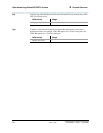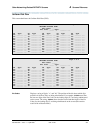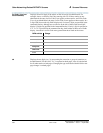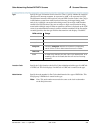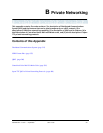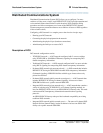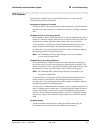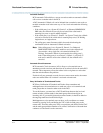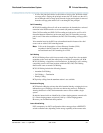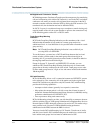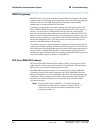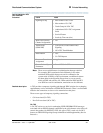
Distributed Communications System B Private Networking
Administration for Network Connectivity
CID: 77730 555-233-504 — Issue 1 — April 2000
314
Automatic Callback
DCS Automatic Callback allows a user at one node to make an automatic callback
call to a user at another node in the DCS.
A DCS Automatic Callback call can be initiated from a terminal at one node to a
terminal at another node in the same way as if at a local node under the following
conditions.
~ If the called party is at a System 85, Generic 2, or Enhanced DIMENSION
PBX node, the callback call can only be activated if the called node is
returning busy tone or special audible ringback.
~ If the called party is at a Generic 3, Generic 1 or System 75 node, the callback
call can be activated if the called node is returning busy tone, Call Waiting
ringback tone, or ringback tone.
~ The calling party must disconnect within 6 seconds after hearing the
confirmation tone for Automatic Callback activation.
Note: If the calling party is on a System 85, Generic 2, or Enhanced
DIMENSION PBX node and is unable to receive the callback call
(for example, a busy single-line voice terminal without Call
Waiting), Automatic Callback is reactivated by the calling party’s
node. If the calling party is on a Generic 3, Generic 1, or System 75
node and is unable to receive the callback call, the callback call is
canceled.
Automatic Circuit Assurance
DCS Automatic Circuit Assurance (ACA) allows a voice-terminal user or
attendant at a node to activate and deactivate ACA referral calls for the entire DCS
network. This transparency allows the referral calls to originate at a node other
than the node that detects the problem.
If referral calls are generated at a node for one or more remote nodes, the remote
nodes are notified when ACA referral is activated or deactivated.
Busy Verification of Terminals and Trunks
DCS Busy Verification of Terminals and Trunks allows attendants and
multiappearance voice-terminal users to make test calls to voice terminals and
trunk groups that are located at other nodes in the DCS.
To use this feature, you must have a DCS Trunk Group between the local and
remote switches, and the trunks in that trunk group cannot insert digits on
incoming calls. If you need digit insertion on these trunks, it should be added on
the outgoing trunk based on the dialed digits.
Multiappearance voice terminal users can busy-verify an adjunct at a remote
location by pressing Verify and dialing the TAC of the tie trunk group to the
remote node. Then they must press Verify a second time and dial the desired TAC
and the trunk group member number to be verified. Verification of the trunk then
continues as if the trunk is on the same node.



